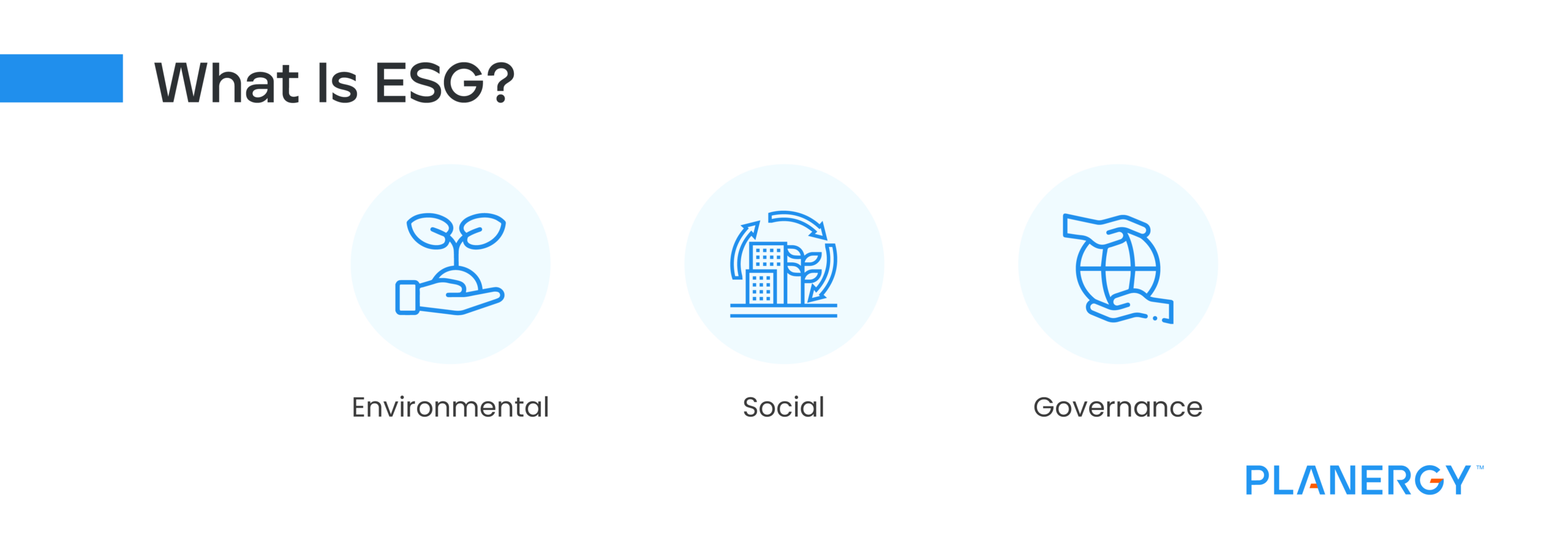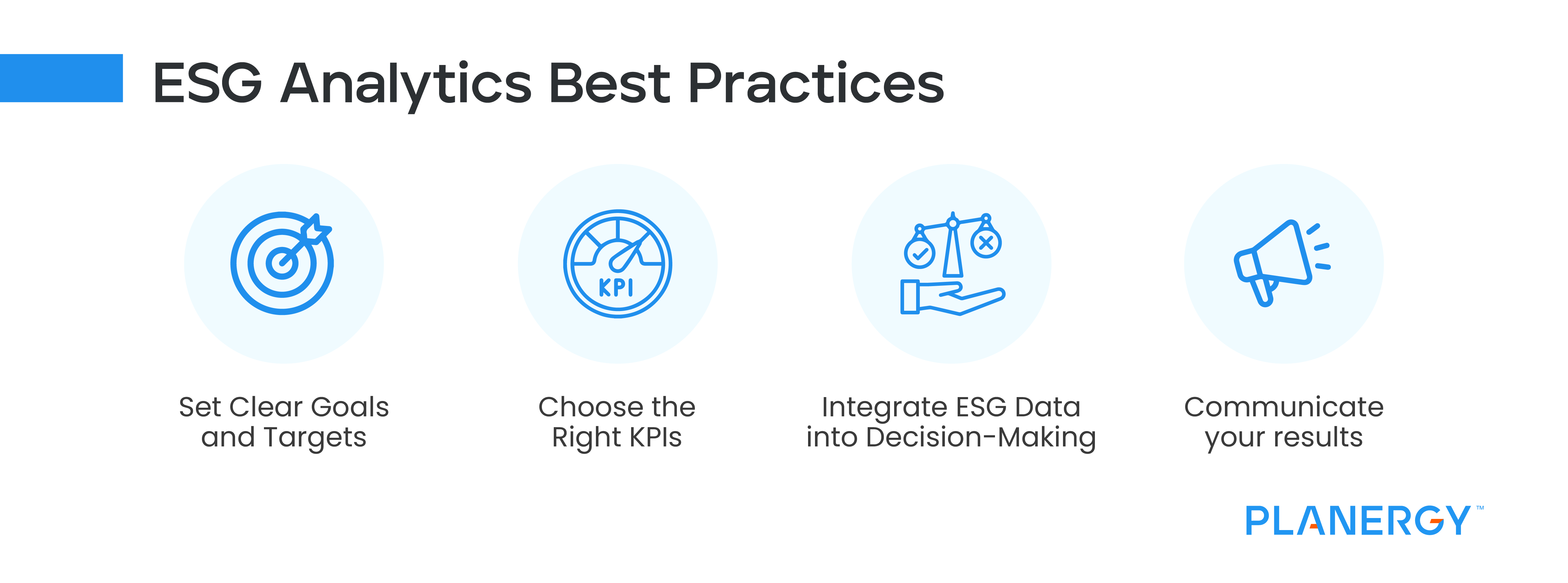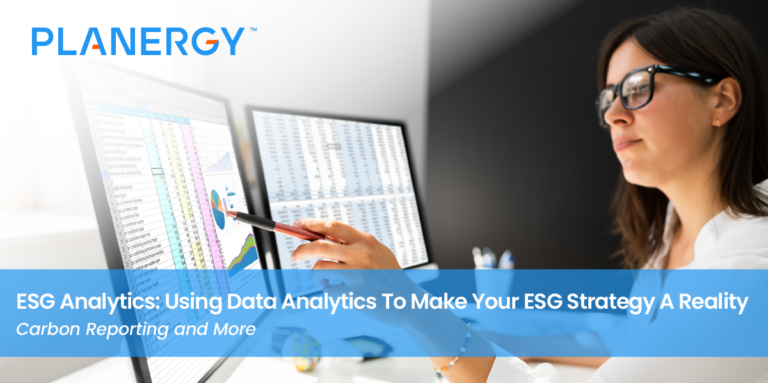Environmental, social and governance (ESG) criteria measure an organization or corporation’s sustainability and societal impact.
In recent years, investors have become increasingly interested in putting their money into companies considering ESG in their operations and decision-making.
-
Environmental: This pillar covers a company’s environmental policies and practices. It includes things like reducing climate risk, emissions reduction, resource conservation, and renewable energy use to help address climate change.
-
Social: The social pillar covers a company’s policies and practices related to human rights, diversity and inclusion, community engagement, and employee relations.
-
Governance: The governance pillar covers a company’s leadership, ethical practices, transparency, and accountability.

Taken together, these three factors make up a company’s “triple bottom line.” For many years, businesses have focused primarily on their financial bottom line – making money.
However, there has been a shift towards more sustainable and responsible business practices in recent years.
This is where the triple bottom line comes in. To be successful in the 21st century, businesses need to focus on all three of their bottom lines – not just their financial bottom line.
ESG Strategy and How Procurement Can Keep You Compliant
ESG strategy is all about considering the impact of a company’s activities on the environment, society, and governance. It’s about ensuring a company is sustainable and responsible in its operations.
Many investors are now using ESG criteria to make investment decisions.
They want to invest in companies that are good stewards of the environment and society.
And they want to avoid companies involved in activities that could harm the environment or society.
There are many different ways to implement an ESG strategy. But one common approach is to set targets for improvement in the three areas – environmental, social, and governance.
Then businesses track their progress towards those targets and report their progress publicly.
This helps to create accountability and transparency around ESG issues. It also helps investors see which companies are making progress on ESG issues and which are not.
Another key part of an ESG strategy is engagement with stakeholders. This means talking to and working with groups interested in the company’s activities – such as employees, customers, suppliers, community members, NGOs, etc.
The goal is to get input from these groups on how the company can improve its performance on environmental, social, and governance issues.
There is no one-size-fits-all approach to implementing an ESG strategy. But by taking into account the impact of its activities on the environment, society, and governance – and by engaging with stakeholders – a company can put itself on a path to long-term success.
To comply with an organization’s ESG strategy, procurement must consider the environmental and social impacts of the goods and services being procured. This includes considering the product’s life cycle, from manufacture to disposal.
It also includes assessing the working conditions of those who produce the product and the environmental impact of the production process itself.
Procurement staff can ensure strategy compliance by keeping these things in mind when choosing products and suppliers working with responsible sourcing.
What ESG Analytics are and Why They’re Important
ESG analytics is a tool used by investors to assess a company’s sustainability.
ESG analytics aims to evaluate a company’s impact on the environment and society and its adherence to good governance practices. It involves collecting various data sets and running analysis.
ESG analytics can be used to screen for companies that are likely to experience financial risks due to environmental or social issues or to identify companies that are leaders in sustainable business practices.
In recent years, there has been a growing interest in ESG investing, and ESG analytics plays an important role in this form of investing.
ESG analytics can help investors make more informed investment decisions by providing information about a company’s sustainability performance.
ESG Ratings
ESG ratings, also known as ESG scores, measure a company’s or investment’s impact on environmental and social issues and governance factors such as board diversity.
The ratings are provided by various organizations, including sustainable investing research firms, stock exchanges, and rating agencies.
ESG ratings can be used by investors to screen companies and make more informed investment decisions.
To receive a high ESG rating, a company typically discloses strong policies and practices related to sustainability issues.
However, it is important to note that there is no uniformity in how ESG ratings are calculated, and the criteria used may vary from one organization to another.
As such, it is important to research the methodology behind any ESG rating before making investment decisions.
The Different Types of ESG Data
ESG data encompasses a wide range of information, from a company’s greenhouse gas emissions to its employee satisfaction levels.
This data can be used to assess a company’s impact on the environment, social welfare, and governance.
While all ESG data is important, some types are more commonly used than others.
For example, companies’ carbon footprints are often tracked, as are their water usage levels and waste production.
However, ESG data can also include information on a company’s treatment of employees, its ethical practices, and its charitable giving.
By understanding the different types of ESG data, investors can make more informed decisions about where to put their money.
How to Get Started with ESG Analytics
ESG analytics is a type of data analysis that helps organizations track and assess their impact on key ESG indicators.
While ESG analytics is relatively new, it is already used by many businesses and investors to make more sustainable and responsible decisions.
There are a few different approaches to ESG analytics, but the most common is to use publicly available data to track an organization’s progress on various metrics and key indicators.
This data can then be compared to industry benchmarks or other organizations’ data to identify areas of improvement. Additionally, many companies are now beginning to collect their own internal data on ESG indicators.
The data sources and data quality heavily influence the results, and if you’re using alternative data, you may not get the results you’re looking for. Many of today’s data analytics tools allow for visualization, which makes it easier to get insights from the data your company collects.
This data can be used to create custom benchmarks and track an organization’s progress over time.
Overall, ESG analytics is a powerful tool that can help organizations make more informed and sustainable decisions.
The Benefits of Using ESG Analytics
ESG analytics is a way of measuring the sustainability and social impact of a company or investment.
ESG analytics considers various factors, including a company’s emissions, water use, employee diversity, and human rights record.
Not only can ESG analytics help investors decide if they want to work with a company, but it can also help companies make sure they’re moving in the right direction.
As more and more people become interested in sustainable investing, ESG analytics is likely to become an increasingly important tool for measuring corporate responsibility.
ESG isn’t something companies can afford to ignore anymore, and analytics give them information in real-time, to help ensure they are headed in the right direction.
Case Studies of Companies That Have Successfully Implemented ESG Analytics
Many companies have successfully implemented ESG analytics. One notable example is the French company Veolia.
In 2013, Veolia launched a “Responsible Solutions initiative,” which used ESG data to help the company make better business decisions.
The initiative was a success, and Veolia was able to reduce its environmental impact and improve its financial performance.
Another company that has successfully used ESG analytics is IBM. IBM has long been a leader in corporate sustainability, using ESG data to inform its sustainability strategy.
In 2011, IBM launched an internal carbon pricing program that used ESG data to set prices for carbon emissions. The program was successful, and IBM reduced its emissions by 16 percent in just two years.
These examples show that ESG analytics can be a powerful tool for businesses looking to improve their sustainability performance.
Tips for Making the Most out of your ESG Analytics Strategy
The global pandemic has brought a new level of scrutiny to how corporations are run. In response, many companies are turning to ESG analytics to track their progress on key sustainability indicators.
However, simply collecting data is not enough – it is also important to know how to use it effectively.
Here are four tips for making the most out of your ESG analytics strategy:
-
Set Clear Goals and Targets
What do you hope to achieve with your ESG data? Do you want to improve your environmental footprint? Boost employee engagement? Or reduce operational risks?
By setting clear goals, you can track your progress and identify areas where you need to improve.
-
Choose the Right Indicators
Numerous indicators can be used to measure ESG performance. It is important to select indicators and KPIs that are relevant to your company, and that will give you the insights you need to reach your goals.
-
Integrate ESG Data into Decision-Making
Data is only useful if it is used to guide decision-making. Ensure ESG data is included in all relevant discussions, from strategic planning to everyday operations.
This will help ensure that sustainability remains a top priority for your company.
-
Communicate Your Results
Sharing your progress on ESG goals can create buy-in from employees, investors, and other stakeholders. It can also help challenge others to do better – ultimately leading to a more sustainable future.
Companies that utilize ESG analytics can make sound, evidence-based decisions about their environmental and societal impact.
This, in turn, allows them to allocate resources effectively and create lasting relationships with key stakeholders. To get started with ESG analytics, consider all the factors involved and set achievable goals.

Procurement Data Plays an Important Role in ESG Analysis
You can invest in ESG reporting and data science tools to help you get ESG insights.
There are a few ESG solutions on the market today to help you get started, but you don’t need to invest in ESG products to do it.
Start by keeping closer track of your procurement data across your supply chain. The data goes a long way in showing you support for various ESG initiatives.




